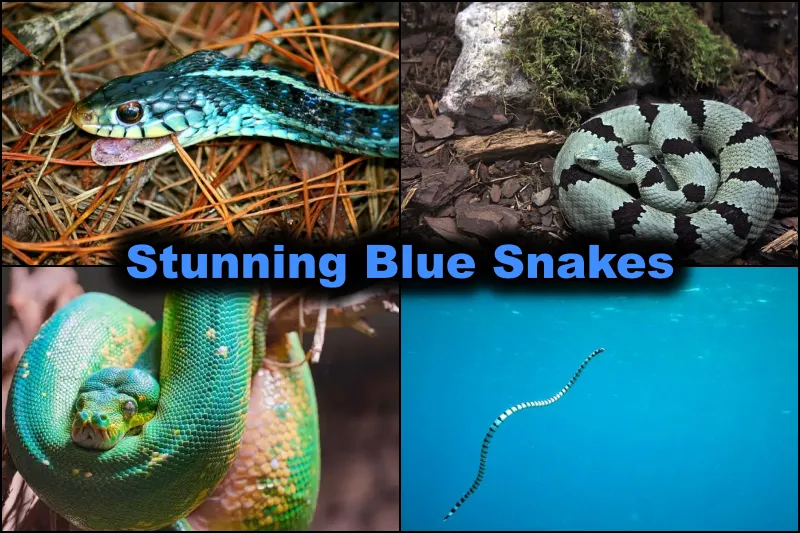There are millions of species of snakes. Many of them are so venomous that they can kill humans in a few seconds, like cobras. Some don’t have a bit, or none at all, of venom, like house snakes. Snakes have many colors.
If you think of any color, then there is a ninety-nine percent chance that there is a shade of that color. We all know the color of the sky is blue, the color of water is blue, and venom is also blue. You might wonder, Do blue snakes actually exist?
23 Stunning Blue Snakes (With Identification)
1. Blue racer snake
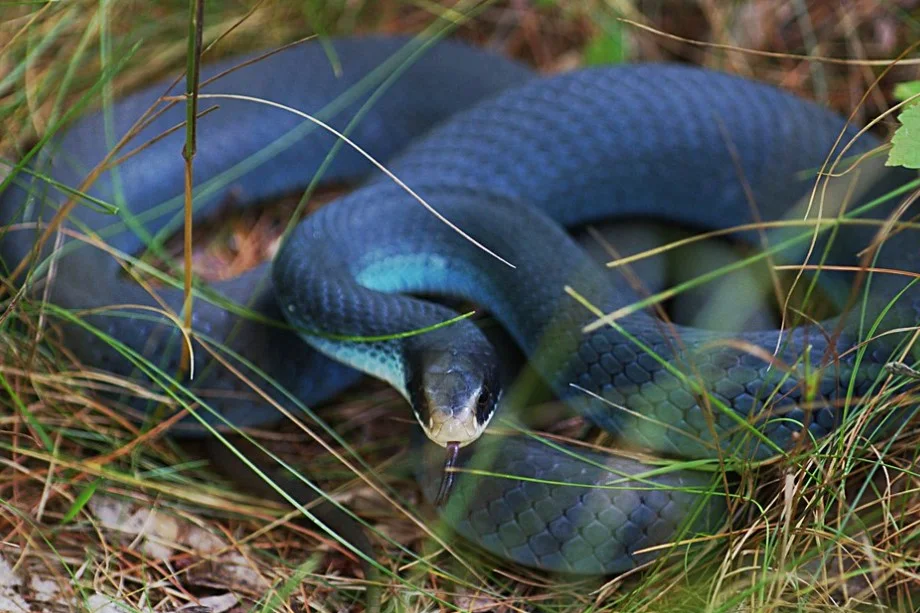
| Scientific name | Coluber constrictor foxii |
| Size | 90-152 cm |
| Diet | Frogs, rodents, lizards, and small snakes |
| Geographical location | United States |
The blue racer is a subspecies of the nonvenomous, colubrid snake. It is also known as the eastern racer. Its distinctive features include creamy white ventral scales, dull gray to brilliant blue lateral scales, and a pale brown to dark gray dorsum.
Blue racers have characteristic black masks, large eyes, and brownish-orange rostral scales. They are one of Ontario’s largest snakes, reaching 90 cm to 152 cm snout-to-vent length.
2. Blue Malayan Coral Snake
| Scientific name | Calliophis bivirgatus |
| Size | ~200 cm |
| Diet | lizards, birds, and frogs |
| Geographical location | Southeast Asia |
The blue coral snake is also known as the blue coral snake or blue Malayan coral snake. It is a species of snake native to Southeast Asia. It is medium-sized, with a slender body and a red head, tail, and belly.
The back is dark blue to black, and it usually has a large blue or white stripe on each flank. It is also closely related to the red-headed krait.
It is a blue venomous snake. Although there is no known antidote, the venom may be useful in managing chronic pain in humans.
3. Blue-lipped sea krait
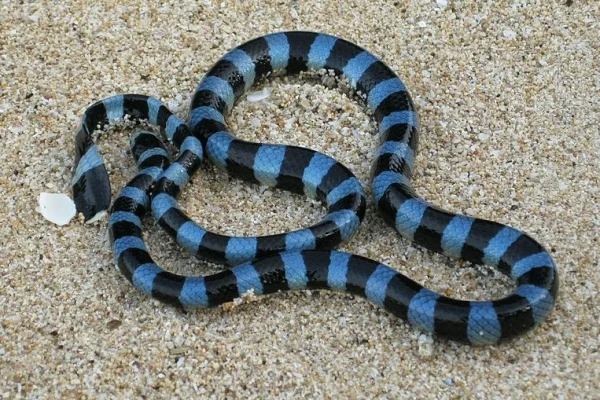
| Scientific name | Laticauda laticaudata |
| Size | 91-107 cm |
| Diet | eel, and small fish |
| Geographical location | China, Japan, Taiwan, India, Bangladesh, Cambodia, Indonesia, Malaysia, Myanmar, the Philippines, Singapore, Sri Lanka, Thailand, and Vietnam |
The blue-lipped sea krait, also known as the blue-banded sea krait or common sea krait, is a species of venomous blue snake found in the Indian and Western Pacific Oceans.
This blue and black snake has large vertical scales, lateral nostrils, 19 longitudinal rows of imbricate scales at midbody, no azygous prefrontal shield, undivided rostral scales, ventrals, and subcaudals, and a dark brown upper lip.
The total length varies with s*x, with males measuring 91 cm and females measuring 107 cm.
4. Eastern Indigo Snake
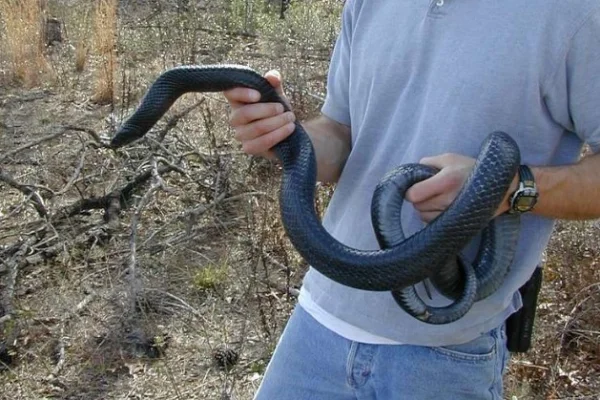
| Scientific name | Drymarchon couperi |
| Size | 280 cm |
| Diet | Arthropods, snakes, birds, lizards, and rodents |
| Geographical location | southeastern United States |
The eastern indigo snake is a large, non-venomous snake species native to the southeastern United States. It has uniform blue-black dorsal scales and a reddish-orange to tan color on the throat, cheeks, and chin.
The snake is known for its glossy, iridescent dorsal, and ventral scales, which can be blackish-purple in bright light. The longest recorded specimen measured 2.8 meters in total length.
Mature male indigo snakes are slightly larger than females due to intra-species competition and combat. A typical mature male measures 1.2–2.36 m in total length and weighs 0.72–4.5 kg. Females typically measure around 1.1–2 m in total length and weigh 0.55–2.7 kg.
5. Blue-striped garter snake
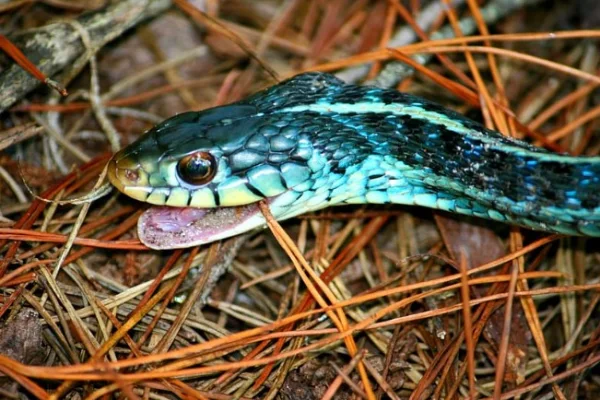
| Scientific name | Thamnophis sirtalis similis |
| Size | 55-137 cm |
| Diet | leeches, salamanders, slugs, freshwater fish, snails, earthworms, and small mammals |
| Geographical location | Florida |
The blue-striped garter snake is a species of common garter snake mostly found in Florida. This blue and black snake has blue stripes on a black background.
The Blue-Striped Garter Snake is a Florida-based subspecies of garter snake with a slender body and a yellow, white, brown, green, or blue stripe on each side and back.
They swallow food whole while alive. They eat leeches, salamanders, slugs, freshwater fish, snails, earthworms, and small mammals. The average length is 55 cm, with a maximum of 137 cm. The snake is thin and smaller.
6. Blue-phase common tree snake
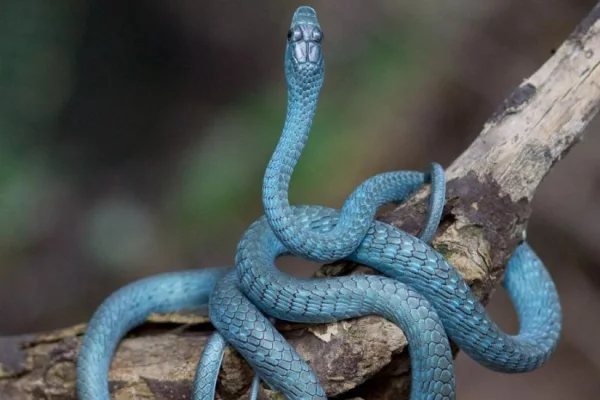
| Scientific name | Dendrelaphis punctulatus |
| Size | 164 cm |
| Diet | Skinks and frogs |
| Geographical location | Australia, Papua New Guinea |
Dendrelaphis punctulatus, also known as the Australian tree snake, common tree snake, or green tree snake, is a non-venomous snake native to Australia, particularly in the northern and eastern coastal areas and Papua New Guinea.
The dorsal body and tail color can vary from yellow to bright green, olive green, black, or blue.
The eyes are large, with golden-colored irises and large, round pupils. This blue and green snake can reach a total length of 1.64 m, including a tail of 44 cm.
Consuming skinks and frogs They do not constrict their prey but use sharp, angled teeth to ‘chew’ it down the esophagus.
7. Banded Rock rattlesnake
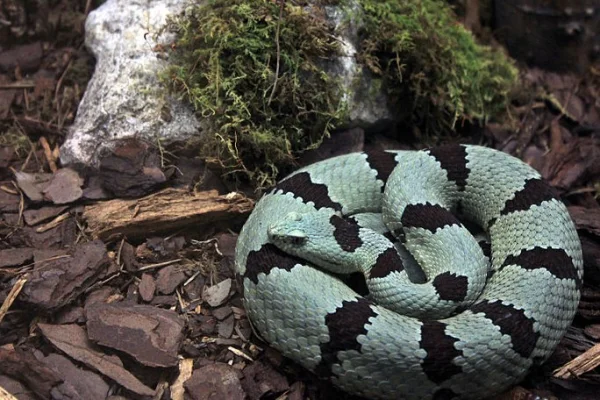
| Scientific name | Crotalus lepidus |
| Size | ~32 cm |
| Diet | lizards, invertebrates, small mammals, birds, and other snakes |
| Geographical location | southwestern United States and northern central Mexico |
Crotalus lepidus is a venomous pit viper species found in the southwestern United States and northern central Mexico.
This small species rarely exceeds 32 cm in length and has a large, rounded head, a heavy body, and vertical pupils. Its tail has a keratin-based rattle, which changes with each molt.
The color pattern varies but generally reflects the color of the rock in the snake’s natural environment. Snakes found near limestone tend to be light gray, while those at higher altitudes have darker colors.
The mottled rock rattlesnake from the Davis Mountains region often exhibits a more pink coloration.
8. White-lipped island pit viper
| Scientific name | Trimeresurus insularis |
| Size | 60-81 cm |
| Diet | frogs, lizards, small birds, and mammals |
| Geographical location | Java, the Sunda Islands, and Indonesia |
The White-Lipped Island Pit Viper, also known as the Sunda Island Pit Viper. It is a venomous blue snake species found in eastern Java and the Lesser Sunda Islands, Indonesia.
They are arboreal snakes with a scalation of 21 rows of dorsal scales at midbody and ventral scales counted at 156–164 in males and 156–167 in females.
Other than that, there are 70–75 subcaudal scales in males and 54–59 subcaudal scales in females. They are aggressive and have toxic venom, but they are not typically fatal to humans.
9. Blue Eyelash viper
| Scientific name | Bothriechis schlegelii |
| Size | 55-82 cm |
| Diet | small vertebrates, including frogs, lizards, birds, mammals |
| Geographical location | Central and South America |
Bothriechis schlegelii, also known as the eyelash viper. It is a venomous pit viper native to Central and South America. This large blue snake has a wide range of color variations and superciliary scales above the eyes.
It is the most common of the green palm pitvipers in the genus Bothriechis and is often seen in zoological exhibits.
The specific name Schlegelii honors Hermann Schlegel, a German ornithologist and herpetologist. No valid subspecies are currently recognized.
10. Sri Lankan pit viper
| Scientific name | Craspedocephalus trigonocephalus |
| Size | ~130 cm |
| Diet | rats, mice, birds, bats, snakes, lizards, frogs, toads, and insects |
| Geographical location | Sri Lanka |
Craspedocephalus trigonocephalus, also known as the Sri Lankan pit viper or Ceylon pit viper. It is a venomous species endemic to Sri Lanka.
This sexually dimorphic, mid-sized, cylindrical species measures 20–25 cm at birth and can grow up to 130 cm in total length. Males are smaller than females, with males growing up to 130 cm.
The snake’s ground color is variable and cryptic, typically green with a black variegated pattern and a black temporal line.
Males tend to have a blue coloration, while females are predominantly green. Some snakes have only the black temporal line and tail, while the rest are green.
These bulky snakes have prehensile, short tails, suitable for their arboreal lifestyle. This venomous blue snake’s bite can cause severe pain, swelling, and blisters.
11. Sunbeam snake
| Genus | Xenopeltis |
| Size | 100-130 cm |
| Diet | caterpillars, ants, harvestmen, moths, worms, snails, and slugs |
| Geographical location | Southeast Asia |
Sunbeam snakes have brown bodies that glow iridescent rainbow colors in sunlight, while their backs appear black to dark purple in the shade. Their scales have a blue, green, yellow, and red sheen when exposed to sunlight.
Iridophores, microscopic layers of nanostructures, cause shimmer in their scales.
A thin layer of dark pigment below the scales highlights the iridescent sheen, giving the snake a violet or blue undertone. The iridophores are on top of the melanin layer.
12. Guatemalan palm-pit viper
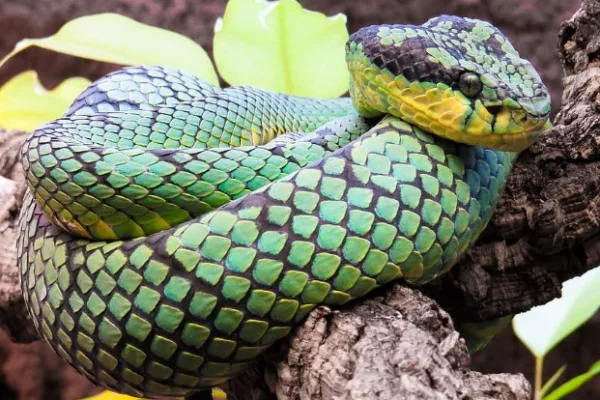
| Scientific name | Bothriechis bicolor |
| Size | 60-100 cm |
| Diet | small rodents, frogs, lizards, and small birds |
| Geographical location | Southern Mexico, Guatemala, and Honduras |
Bothriechis bicolor is a venomous pit viper species found in southern Mexico, Guatemala, and Honduras.
Its name refers to its contrasting ventral and dorsal colors. Adults are typically 60–70 cm long with a slender body.
Their color pattern consists of green or bluish-green ground, a uniform green dorsum, blue interstitial skin, and a uniform yellowish-green belly. No subspecies are currently recognized.
13. Side-striped palm pit viper
| Scientific name | Bothriechis lateralis |
| Size | 60-97 cm |
| Diet | small birds, rodents, lizards and frogs |
| Geographical location | Costa Rica and western Panama |
Bothriechis lateralis is a venomous pit viper species found in Costa Rica and western Panama. Adult specimens are slender snakes with a prehensile tail.
Their color pattern consists of emerald green to bluish green ground color overlaid with yellow alternating paravertebral vertical bars.
Some scales may be blue or black-tipped. The belly is uniformly yellow-green, with a pale yellow stripe as a border. The head is uniformly green, and a blue or blue-gray postocular stripe may be present.
14. Rainbow Reticulated Python
| Scientific name | Malayopython reticulatus |
| Size | 70-122 cm |
| Diet | Pigs and Deer |
| Geographical location | America, Southeastern Asia |
Rainbow snakes, despite their mythical appearance, are real snakes with microscopic crystals on their outer scale layer that create a band of colors when light hits them.
These iridescences, which are rare and only found in zoos or experienced reptile keepers, are responsible for refracting light into different hues. Species like the white-lipped python, black python, and Brazilian rainbow boa are examples of true rainbow snakes.
15. Butterfly viper
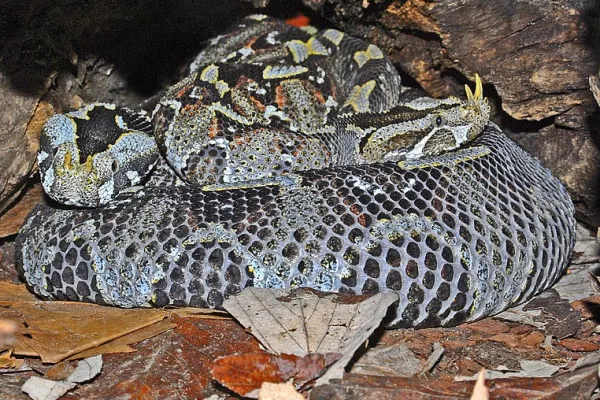
| Scientific name | Bitis nasicornis |
| Size | 72-107 cm |
| Diet | small mammals, and amphibians |
| Geographical location | West and Central Africa |
Bitis nasicornis is a large viper species found in West and Central Africa. This large blue snake is known for its striking coloration and prominent nasal “horns”.
It is venomous and varies in length from 72 to 107 cm (28 to 42 inches). The head is narrow, flat, triangular, and relatively small, with a thin neck and horn-like scales on the nose.
The eyes are small and set well forward, and the fangs are not large. The midbody has 31–43 dorsal scale rows, 117–140 ventral scales, and anal scales. The subcaudals number 16–32, with males having a higher count.
The color pattern consists of 15–18 blue or blue-green oblong markings enclosed within black rhombic blotches.
The top of the head is blue or green, overlaid with a distinct black arrow mark, while the belly is dull green to dirty white, strongly marbled, and blotched in black and gray.
16. San Francisco Garter Snakes
| Scientific name | Thamnophis sirtalis tetrataenia |
| Size | 45-139 cm |
| Diet | toads, small fish, worms, and even rodents |
| Geographical location | California |
The San Francisco garter snake is an endangered subspecies of the common garter snake, endemic to San Mateo County and the northern part of coastal Santa Cruz County in California.
Adults can grow up to 18–55 inches. They have keeled dorsal scales of blue-green, bordered with stripes of black, red, and blue-green.
Their large eyesight allows them to be active during the day. Garter snakes are harmless to humans, with bites causing only mild irritation and no fangs.
17. Baron’s Blue racer
| Scientific name | Philodryas baroni |
| Size | 150–180 cm |
| Diet | small mammals, rodents |
| Geographical location | South America |
Philodryas baroni, also known as Baron’s Blue Racer. It is a rear-fanged venomous snake native to South America.
This blue snake can reach a total length of 150–180 cm, with males being smaller than females. The tail is about thirty percent of the total body length.
The head is small and elongated, with a flexible nasal protuberance in males. The body color is variable; it is usually green but can be blue or brown. The ventral area can be white or yellowish-white, sometimes with shades of green or blue.
18. California red-sided garter snake

| Scientific name | Thamnophis sirtalis infernalis |
| Size | 65–100 cm |
| Diet | frogs and newts and their larvae, fish, birds, small mammals, reptiles, earthworms, slugs, and leeches |
| Geographical location | North America |
The California red-sided garter snake is a subspecies of the common garter snake native to North America.
This blue snake features a basic pattern of three yellow or blue stripes over a primarily red body with a row of black spots or blotches.
The subspecies features an orange or redhead and can vary significantly in appearance based on its geographical location. Females typically reach 90–100 cm, while males reach 65–75 cm.
19. Yellow-lipped sea krait
| Scientific name | Laticauda colubrina |
| Size | 87.5 cm |
| Diet | eel, and small fish |
| Geographical location | South and East Asia |
The yellow-lipped sea krait, also known as the banded sea krait or colubrine sea krait. It is a venomous sea snake found in tropical Indo-Pacific oceanic waters. It has distinctive black stripes, a yellow snout, and a paddle-like tail for swimming.
This blue and black snake’s head is black with lateral nostrils and an undivided rostral scale, while its body is sub-cylindrical and taller than its width. Its upper surface is blueish gray, while its belly is yellowish with wide ventral scales.
Males are 875 mm (2 ft 10.4 in) long, while females are significantly larger, with an average total length of 1.42 m (4 ft 8 in) and a tail length of 145 mm (5.7 in).
20. Vietnamese blue beauty/blue beauty snake
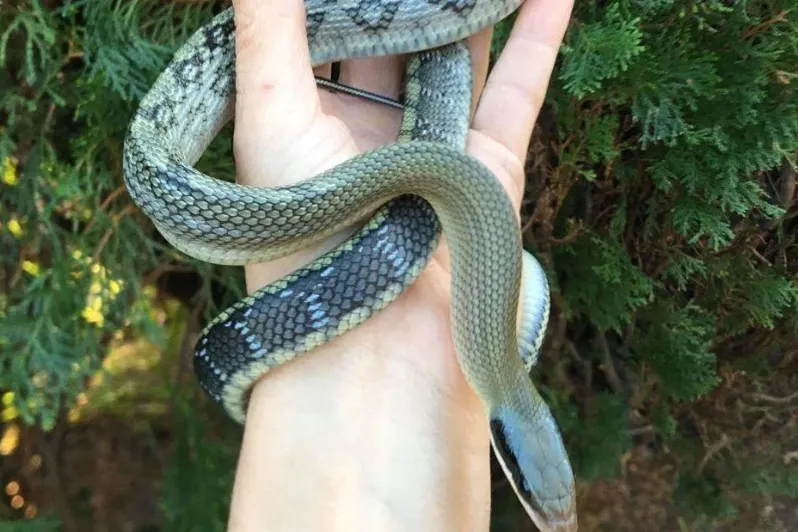
| Scientific name | Elaphe taeniura callicyanous |
| Size | 150-335 cm |
| Diet | rodents |
| Geographical location | Vietnam, Cambodia, and Thailand |
The Vietnamese Blue Beauty Snake is a subspecies of the Beauty Rat Snake. This large blue snake can grow 5–11 feet in length.
Its slender blue or silver body features a solid head and neck with a thick dark stripe from each eye to the back of its mouth.
The rest of the snake’s body is covered with dark geometric patterns, with the tail often solid in color with thin light-colored stripes.
This popular subspecies is found in tropical rainforests in Vietnam, Cambodia, and Thailand.
21. Green tree python
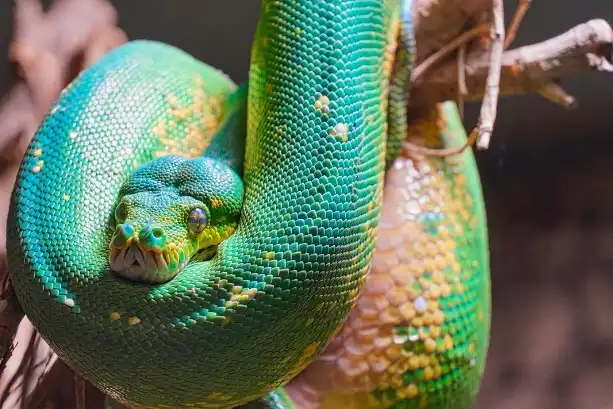
| Scientific name | Morelia viridis |
| Size | 213 cm |
| Diet | birds and small mammals |
| Geographical location | Indonesia |
Being known as the green tree python, this species of python has a blue color too, but rarely.
Green tree pythons are arboreal snakes that grow up to 7 feet in length and have pit organs around their lips that detect heat.
These blue snakes feed on birds and small mammals, using their teeth to seize prey and wrap their coils around it until death occurs.
Male and female green tree pythons mate in trees during cool weather, with the female laying clutches of 6-32 eggs on the ground and coiling her body around them to protect them.
The eggs hatch in about two months, and the female returns to the trees. Juveniles, which are bright yellow, red, or dark brown, turn green as they mature.
22. Blue and yellow mangrove snake
| Scientific name | Boiga dendrophila |
| Size | 240-275 cm |
| Diet | reptiles, birds, and small mammals |
| Geographical location | Southeast Asia |
Boiga dendrophila, also known as the mangrove snake or gold-ringed cat snake. This blue or electric blue and yellow snake is a rear-fanged venomous snake in the Colubridae family endemic to southeast Asia.
It is one of the largest cat snake species, averaging 8–9 feet in length. Although moderate envenomations have been reported, there has never been a confirmed fatality.
The snake has a long snout, rostrally broader than deep, and a preocular extending to the upper surface of the head.
It has 21 scales, a vertebral row enlarged, ventrals 209–239, anal entire, and subcaudals 89. The blue snake has black or electric blue above and yellow transverse bands, yellow labials, and a black or bluish lower surface.
23. Blue Ring-necked snake
| Scientific name | Diadophis punctatus |
| Size | 25-38 cm |
| Diet | smaller salamanders, earthworms, slugs, lizards, frogs |
| Geographical location | New Mexico, Utah |
Ring-necked snakes have a similar morphology across their distribution, with dorsal coloration being solid olive, brown, bluish-gray, or smoky black, and a distinct yellow, red, or yellow-orange neckband.
Some populations in New Mexico, Utah, and other locations may not have distinctive neck bands.
This blue snake has darker coloration on head coloration than the rest of the body, and ventrally, the snakes exhibit yellow-orange to red coloration broken by crescent-shaped black spots. Size varies across the species, with adults measuring 25–38 cm in length.
Note: There are numerous other captivating blue snake morphs suitable as pets. If you’d like a list of additional blue snakes with their morphs, please indicate your interest in the poll below.
[socialpoll id=”2915947″]
Conclusion:
Blue snakes are one of the most amusing things in nature. Like other beautiful creatures, snakes are beautiful but dangerous. So whenever you find a snake, it’s better to be aware and safe than to look for other consequences.
Our search ends here today, but it’s not over. Still, we have a lot to search for. The search for knowledge never ends. The earth has a vast, wide, and vivid variety of flora and fauna. you might not be aware of. But for today, we stop here. Keep an eye out for HowItSee.
FAQs
Q1: Do blue snakes really exist?
Ans: Yes, there are several species of blue snakes, each with distinct characteristics and geographic locations.
Q2: What are some blue snake species?
Ans: Examples include the Blue Racer, Blue Malayan Coral Snake, Blue-lipped Sea Krait, and Eastern Indigo Snake, among others.
Q3: Are blue snakes venomous?
Ans: Some blue snakes, like the Blue Malayan Coral Snake and Blue-lipped Sea Krait, are venomous. Others, such as the Eastern Indigo Snake, are non-venomous.
Q4: What do blue snakes eat?
Ans: Diets vary among species, with preferences for frogs, rodents, lizards, birds, and other small animals.
Q5: Are there blue venomous snakes with medicinal properties?
Ans: Yes, the venom of the Blue Malayan Coral Snake is considered to have potential uses in managing chronic pain in humans.
Q6: Are there blue snakes in the United States?
Ans: Yes, the Blue Racer is a subspecies found in the United States, particularly in regions like Ontario.
Q7: What distinguishes the Eastern Indigo Snake?
Ans: The Eastern Indigo Snake has a glossy, iridescent appearance with blue-black dorsal scales and reddish-orange to tan colors on the throat and chin.
Also Read:

As a content writer, I like to write about different niches. I have a curiosity about nature and animals. And like to learn about them. Through my writing, I like to share my experience and knowledge with you. I hope you are enjoying it too.
